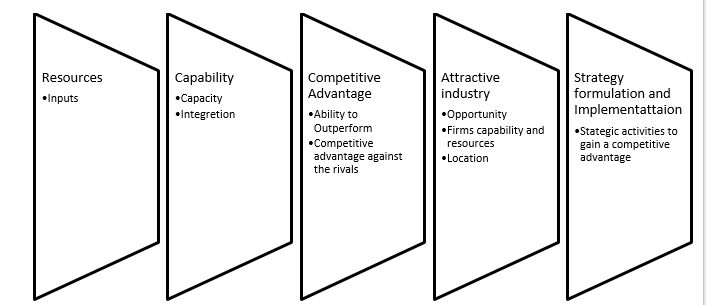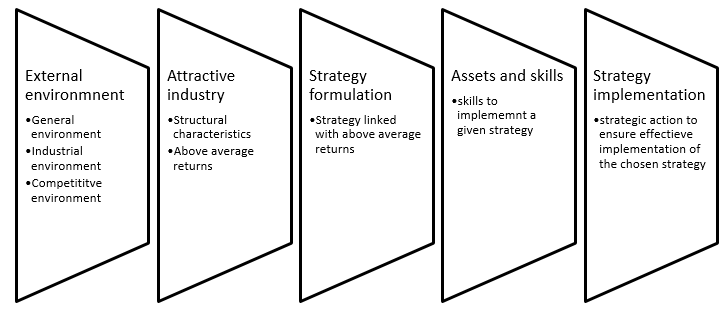Introduction
Apple Inc. is a multinational company with its stocks listed in the New York Stock Exchange. The symbol of Apple Inc. stock prices is AAPL, and it suspends an approximate amount of $145 billion in cash and investment. However, two-thirds of the amount represents investments in foreign countries. Apple Inc. deals with a number of electronics such as computers, computer products and the smart phones. Apple Inc. manufactures exceptional designs of iPhones, iPads, iPods, Macintosh and extemporary operating systems.
Since its establishment in 1976, Apple Inc. has progressed and currently, it ranks top amongst the companies providing technological related products and services (Adam, 2011). This paper discusses the various aspects that influence the developments of Apple Inc. and its position in the security and stock market. The aspects include globalization, technology, the industrial organization model, the resource based model, Apple’s vision and mission, and the strategic roles played by the various stakeholders.
How globalization and technology have influenced Apple Inc
The world is becoming a global village. These globalization and technology changes stimulate Apple Inc. activities. The company has employed strategies to combine its strengths and the available opportunities to market its products and have a great market share in the global and technological world. Apple Inc. has employed the cost leadership strategy and the differentiation strategy to gain a competitive advantage. In attaining the differentiation strategy, Apple Inc. has embarked on manufacturing unique products in terms of design.
Apple Inc. invents new designs of electronics into the market while upgrading the existing products and services to meet the demands of customers. Globalization and technology have inspired Apple Inc. to innovate hardware and software products. Apple Inc. is working tirelessly towards designing unique operating systems that integrate business units and design units. It invests heavily on market researches that help in the diversification and enhancement of the products and services.
The four main driving forces of globalization are the technological forces, the global cost forces, the global market forces, and the political and macroeconomic forces. The global market forces have played a great role in driving Apple Inc. into upgrading their operations to gain a competitive advantage in both the local markets and the foreign markets. Apple Inc. has identified the opportunities that arise in the international markets. It has thus expanded its production to attain the foreign market demands.
The technological forces have driven Apple Inc. to diversify and differentiate their products. However, the competitiveness priorities that insist on quality, customization, quick delivery, product reliability, and responsiveness to customer needs come with a cost. These global cost forces have influenced Apple Inc. to produce more, invest more in marketing products, and selling more to generate great profits.
The profits help in meeting the increased direct and indirect costs. The foreign markets expose Apple Inc. to unexpected currency devaluations, whereby, the real exchange rates can change overnight. This has influenced Apple Inc. to become alert. In case the economic conditions in a nation are favorable, Apple Inc. takes advantage to establish the market in the foreign nation. However, whenever the economic conditions are unfavorable, Apple Inc. shifts its business to the local vendors. In general, globalization and technology has influenced the activities of Apple Inc. to the advantage of the customers.
Apple Inc.’s Resource based model
The resource-based model explains a company’s internal activities. Apple Inc. has a unique package of its internal perspectives. The main resource inputs into Apple Inc. include capital equipments, brand names and patents, and the skilled and talented employees. The tangible and intangible resources work together to perform the real task of production. Apple’s resource inputs determine their capability and capacity in the market.
Apple Inc. competitive advantage is determined by its ability to outperform and produce diversified and integrated products. To manage its attractiveness, Apple Inc. takes adequate time to identify business opportunities and thereby locate their businesses and premises at strategic locations. After considering the above-mentioned internal strategies, Apple Inc. takes a stringent analysis of the external factors and exploits the external environment to earn above average returns. Apple Inc.’s resource based model is as shown below.

Apple Inc.’s Industrial organization model
The industrial -based model explains the company’s activities as they relate to the external environment. Apple Inc. has employed unique strategies in studying its general environment, industrial environment, and the competitive environment. After gaining a critical understanding of the various environments, Apple Inc. constructs an attractive industry by developing differentiated and unique products. Every form of strategy employed by apple Inc. aims at meeting above average returns. The skilled employees employ strategic actions to ensure efficient implementation of the chosen strategy. Apple Inc.’s industrial organization model is as shown below.

Apple Inc.’s vision, mission, and stakeholders and how they influence the company’s overall success
Apple Inc. is a company whose mission is to protect the environment, protect its employees and its customers. With this mission in mind, every activity at Apple is measured accordingly (Adam, 2011). Apple’s success in the corporate social responsibility lies in the fact that it aims at preserving and conserving the environmental resources for generations to come. By ensuring the health and safety of the employees and the customers, Apple is able to manufacture technological innovative products. It is noteworthy that employees whose demands are fully met by the company work with strong hearts towards the success of the company. Apple Inc. employees are treated with the utmost care.
They are the internal stakeholders who have powers to dictate what happens provided it is worthwhile. Apple Inc. employees have reasonable salaries, and they obtain Apple products at a discount. Generally, this favorable work environment ensures loyalty of Apple’s employees. The employees keep on innovating and inventing products and services to meet the demands of the customers. The loyal employees enable the company to produce the best personal computers, differentiated software, peripherals, and excellent internet offering among other diversified products.
Apple’s stakeholders have also played a significant role in influencing its success. Stakeholder’s investments and shares have enabled the company to diversify and invest globally. The various shareholders of Apple Inc. comprise of preference and common shareholders, the lenders, the loyal employees of apple, the loyal customers, suppliers, and the music industry among others (Young & Simon, 2005). The lenders and shareholders provide financial support while the supplier, the music industry and the software developers provide the input necessities. The employees provide the most required services and the customers purchase and consume the products and services to complete the chain of production. All stakeholders pull forces to enable the success of the company.
Conclusion
Apple Inc. and other technological companies have made the world a global village. Their competitiveness works towards benefiting the customer. Apple has played a great role in integrating the global market forces and the political and macroeconomic forces to explore the world market. It is a clear indication that that globalization and technology is bringing people from the darkness into the light. Technology is evolving on a daily process, whereby, technology in the next 30 years is unimaginable.
References
Adam, L., (2011). How Apple works: inside the world’s largest startup. Web.
Young, J.S., & Simon, W.L. (2005). Icon Steve Jobs: The Greatest Second Act in the History of Business. New York, NY: John Wiley & Sons.

